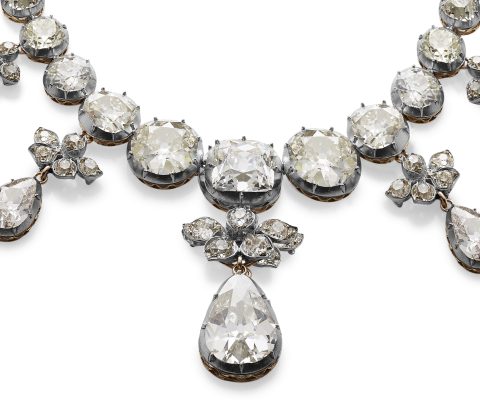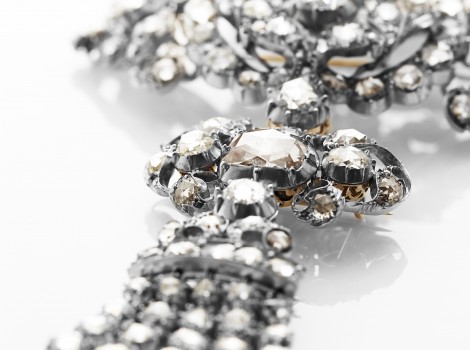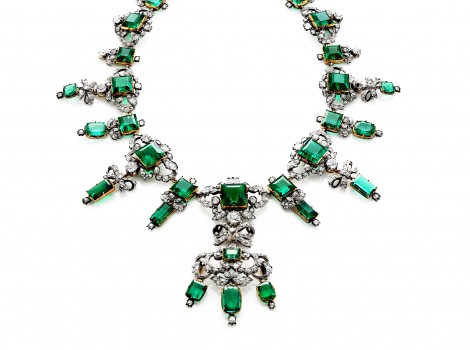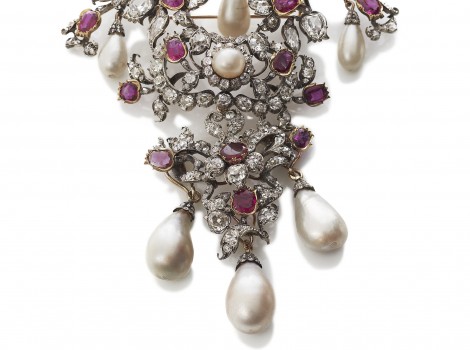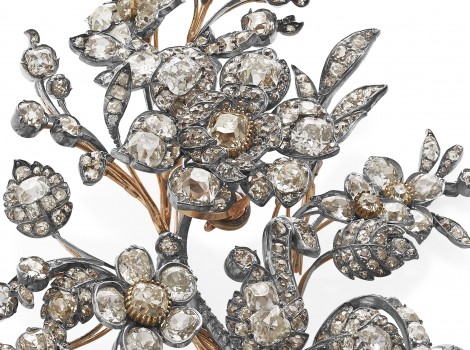The brilliant set
The brilliant set is part of the crown jewels.
The brilliant set consists of a necklace, a brooch and a set of ear pendants. In its current form, the set was created in 1840 for Caroline Amalie (1796–1881), who wore it for her royal anointing ceremony that year. With inspiration from the diamond necklace given by Emperor Napoleon to his second consort, Empress Marie Louise, in 1811, the jewellery firm C.M. Weishaupt & Söhne of Hanau in Hesse, Germany, created a necklace of brilliant-cut diamonds with far more carats than the French piece that inspired it.
From ring to hairpin
Many of the stones in the brilliant set came from the jewels that Queen Sophie Magdalene (1700–1770) left to the Danish crown in her will in 1746. This includes the large drop-shaped diamond pendeloque in the centre of the necklace, which was originally part of Queen Sophie Magdalene’s hairpin. The hairpin appears to have held special meaning for the Queen, as it was not just the most precious but also the first piece of jewellery to be listed in her will. Perhaps the Queen’s attachment to the hairpin was due to another large stone in the pin: a large brilliant-cut diamond that is now included in the string of brilliants in the necklace. Reportedly, this particular stone was originally set in a ring that Sophie Magdalene gave Crown Prince Christian (VI) at the couple’s wedding in Saxony in 1721.
From hairpin to ring
The large square brilliant in the middle of the necklace also belonged to Sophie Magdalene, who wore it in her hair or as a pendant on a necklace. In 1766, it was set in a ring that the newly married Christian VII gave to his English bride, Queen Caroline Mathilde (1751–1775), just 15 years of age and recently arrived from the British royal court. It is easy to imagine that the sheer size of the stone may have given her a sense of both the splendour and the gravity of the position that awaited her – a position she would later squander through her illicit affair with the court physician, Johann Friederich Struensee. In 1772, she was divorced from Christian VII and subsequently deported to Hannover. Her ring, with the large brilliant, was returned to the Danish crown. Two generations later, Caroline Amalie had the stone incorporated into the current brilliant set.
The six other large brilliants in the necklace were also worn by Queen Caroline Mathilde. Originally, the six drop-shaped diamonds were set in a pair of earrings that she received as gift from Christian VII, along with the ring with the large brilliant, at their wedding in 1766. The other brilliants came from Queen Sophie Magdalene’s and Princess Charlotte Amalie’s jewellery collections. The brilliant set also includes a pair of ear pendants. The earrings are fastened with standard clips, but in order to distribute their weight and secure them better, each earring also has a brace that wraps around the ear.
Sold and recreated
The brilliant set includes a brooch shaped like a bouquet of flowers with leaves, entirely covered in brilliants. Several of the flowers have a yellow diamond at the centre. In another sophisticated detail, the largest flower is mounted on a spiral spring that vibrates when the brooch is worn. This maximises the play of light in the many brilliant-cut stones. The design of the brooch was inspired by a similar brooch created by Queen Sophie Magdalene, which Caroline Mathilde sold, with Struensee’s help, shortly after their affair had begun.
With the design of the new brooch and the central placement of the large stone from Caroline Mathilde’s ring in the necklace, Caroline Amalie simultaneously made amends for past transgressions and gave a discreet nod to her grandparents – Caroline Mathilde and Struensee.
The brilliant set during the reign of HM Queen Margrethe
During her reign, HM Queen Margrethe often wore the brilliant set, or parts of it, on special occasions. For example, she wore the necklace, the earrings and the brooch for the wedding of the current Royal Couple at the Church of Our Lady in 2004.
Photo Iben Kaufmann

 Dansk
Dansk
 English
English
 Deutsch
Deutsch

